One swallow does not a summer make
By Colin Twiggs
February 18th, 2016 8:00 p.m. AEDT (4:00 a.m. EST)
Advice herein is provided for the general information of readers and does not have regard to any particular person's investment objectives, financial situation or needs. Accordingly, no reader should act on the basis of any information contained herein without first having consulted a suitably qualified financial advisor.
"One swallow does not a summer make, nor one fine day; similarly one day or brief time of happiness does not make a person entirely happy."
~ Aristotle (384 BC - 322 BC)
Similarly, one brief rally does not make a bull market.
Dow Jones Global Index found support at 270 and is rallying to test resistance at the former primary support level of 290. 13-Week Twiggs Momentum peaks below zero flag a strong primary down-trend. Breach of 270 would confirm another decline. Recovery above 290, on the other hand, would indicate a more gradual down-trend rather than a reversal; respect of the descending trendline at 300 would confirm.
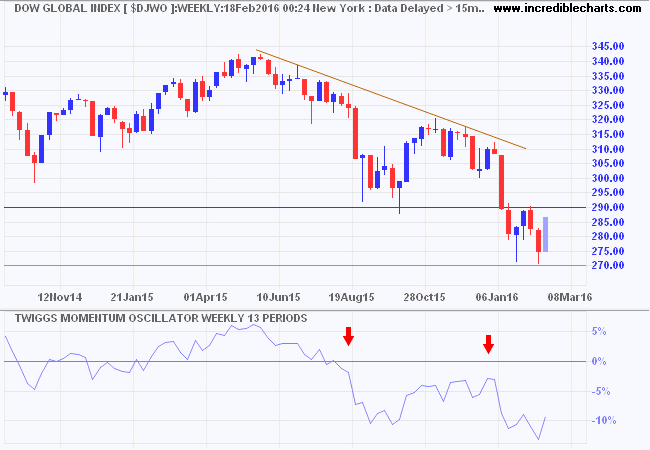
* Target calculation: 290 - ( 320 - 290 ) = 260
Dow Jones Industrial Average recovered above primary support at 16000, long tails on weekly candles reflected committed buying. Rising 13-week Twiggs Money Flow indicates medium-term buying pressure. Breakout above 16500 would signal a test of 17000. But respect of 17000 is likely and would warn of continuation of the primary down-trend. Breach of 16000 would confirm the signal, offering a target of 14000*.
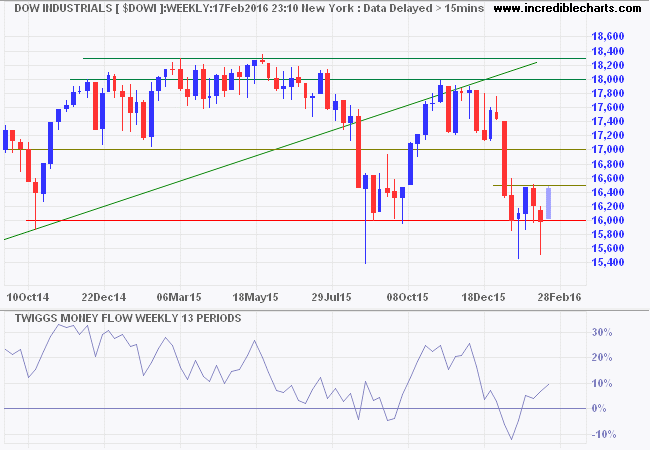
* Target calculation: 16000 - ( 18000 - 16000 ) = 14000
The S&P 500 is similarly headed for a test of 1950. Rising 13-week Twiggs Money Flow again reflects medium-term buying pressure. Reversal of the primary trend is unlikely and breach of support at 1850 would confirm a decline to 1700*.
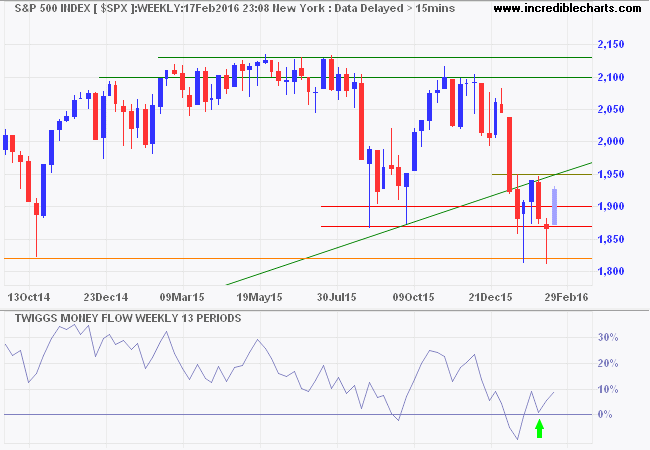
* Target calculation: 1900 - ( 2100 - 1900 ) = 1700
CBOE Volatility Index (VIX) is headed for another test of support at 20. Respect is likely and would confirm that risk remains elevated.
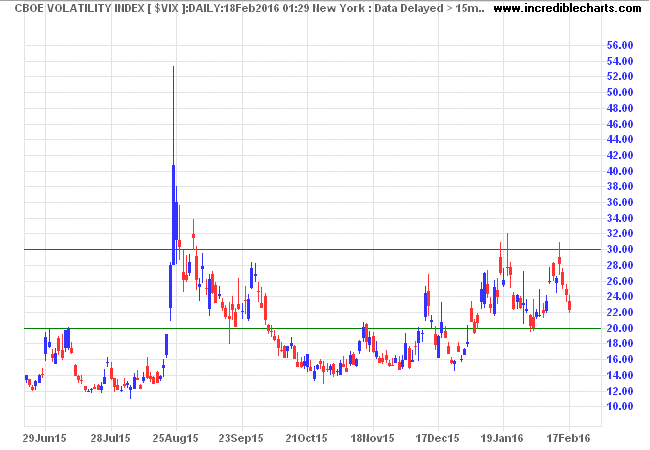
Canada's TSX 60 broke resistance at 750. Rising 13-week Twiggs Momentum suggests that a bottom may be forming, but only another test of 700 would confirm this.
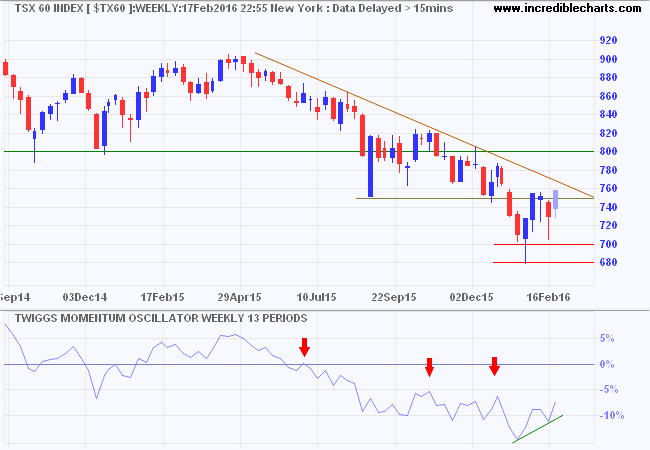
* Target calculation: 700 - ( 750 - 700 ) = 650
Transport
Bellwether transport stock Fedex (FDX) found support at $120. Recovery above $140 would signal a test of $150 and the descending trendline. But the primary down-trend remains intact.
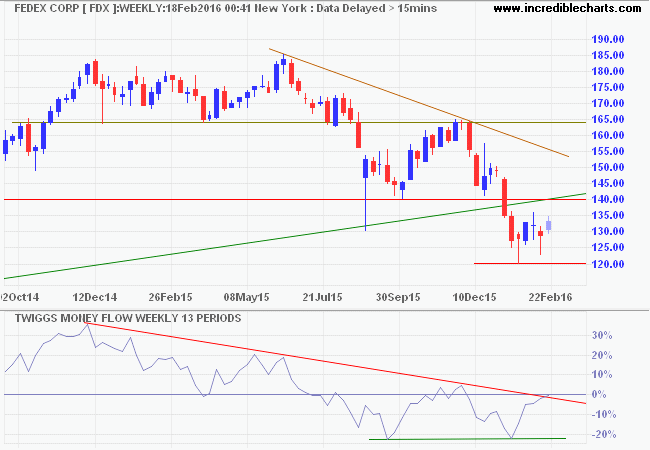
Europe
Germany's DAX is testing resistance at 9500. The rally may well follow-through to 10000 but buying pressure on 13-week Twiggs Momentum appears secondary and the primary down-trend is intact.
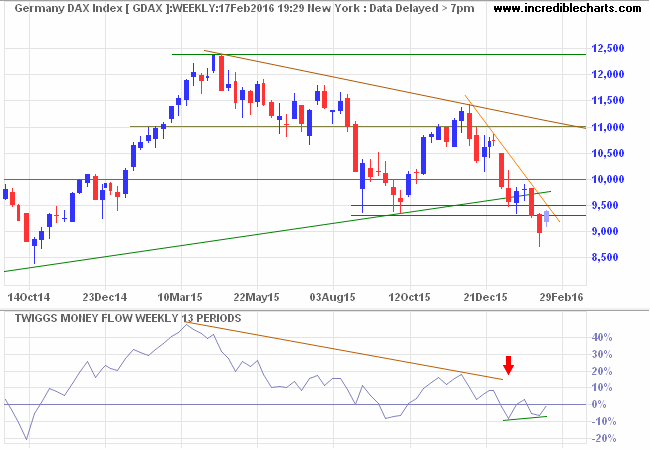
* Target calculation: 9500 - ( 11500 - 9500 ) = 7500
Deutsche Post AG (DPW.DE), Europe's bellwether equivalent of Fedex, found support at € 20. A rally that respects resistance at € 23 would confirm a strong primary down-trend, while respect of € 25 and the descending trendline would indicate a more gradual decline. 13-Week Twiggs Money Flow declining below zero signals long-term selling pressure.
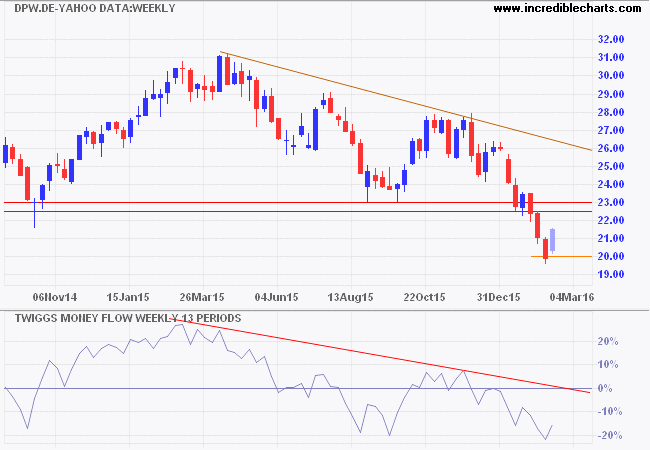
The Footsie recovered to 6000, but expect strong resistance at this level (and the declining trendline). 13-Week Twiggs Momentum oscillating below zero flags a primary down-trend. Long-term target for a decline remains 5000*.
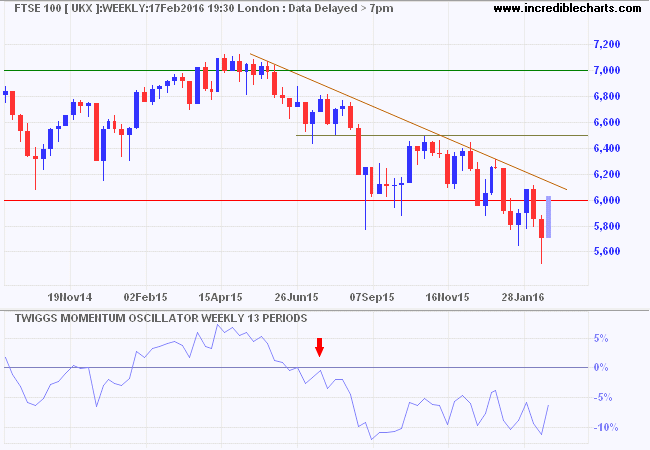
* Target calculation: 6000 - ( 7000 - 6000 ) = 5000
Asia
The Shanghai Composite Index found support at 2700. Expect a test of resistance at 3000, but the primary trend is clearly down and likely to remain so for some time.
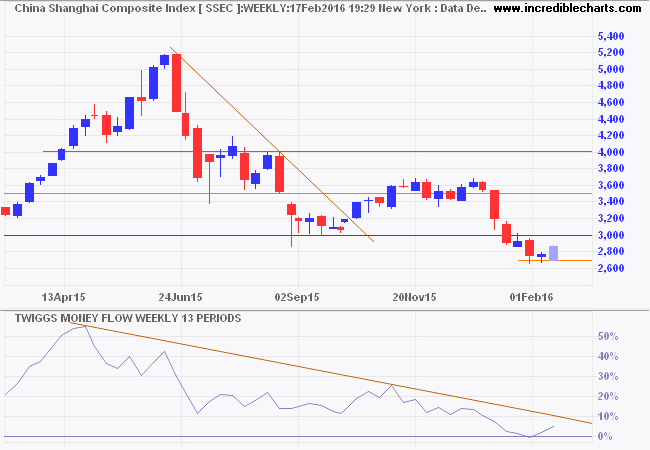
* Target calculation: 3000 - ( 3600 - 3000 ) = 2400
Japan's Nikkei 225 Index is retracing to test the new resistance level after breaking primary support at 17000. Respect is likely and would confirm the primary down-trend. Decline of 13-week Twiggs Money Flow below zero strengthens the bear signal.
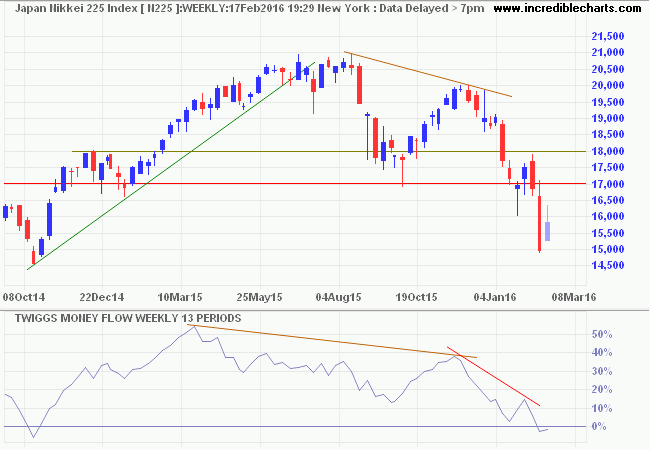
* Target calculation: 17 - ( 20 - 17 ) = 14
India's Sensex broke the bottom border of its trend channel, testing support at 23000. The primary down-trend is accelerating. Respect of resistance at 24000 is likely and would warn of a test of 22000. Respect of resistance at 25000, on the other hand, would suggest a more gradual descent.
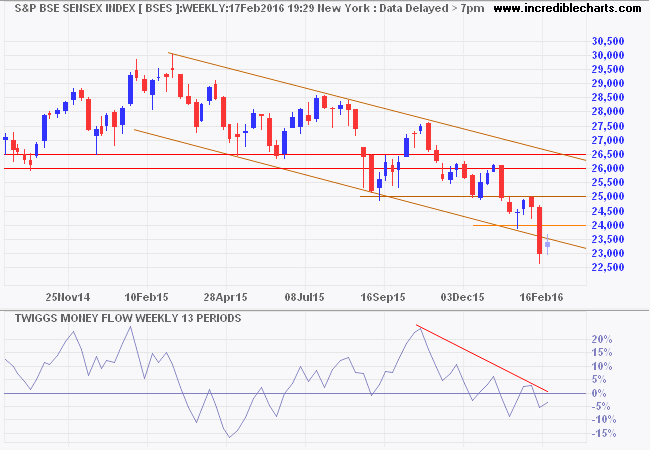
* Target calculation: 25000 - ( 27500 - 25000 ) = 22500
Australia
The ASX 200 retraced to test resistance at 5000 and the descending trendline. Respect of the latter is likely and would confirm the primary down-trend. Bullish divergence on 13-week Twiggs Money Flow indicates medium-term (secondary) buying pressure. The weight of the market remains on the sell (bear) side. Respect would indicate a test of support at 4600, but the long-term target remains 4000*.
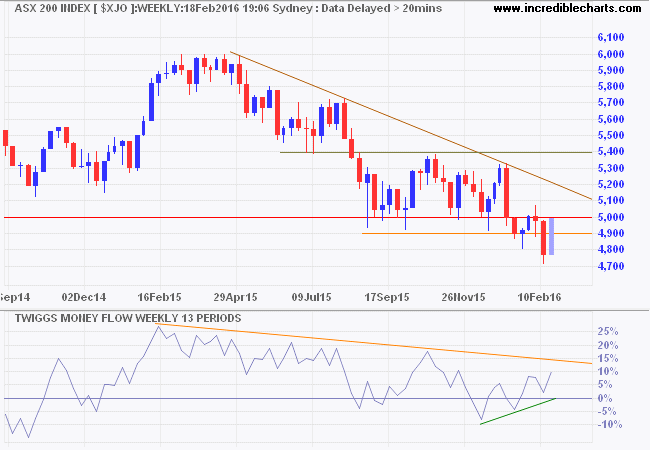
* Target calculation: 4850 - ( 5050 - 4850 ) = 4650; 5000 - ( 6000 - 5000 ) = 4000
Banks are taking a hammering, with the Finance sector ($XFJ) in a clear down-trend. Retracement to test resistance at 5700 is secondary. A rally that respects the descending trendline would suggest a decline to 5100*. Declining 13-week Twiggs Money Flow reflects long-term selling pressure.
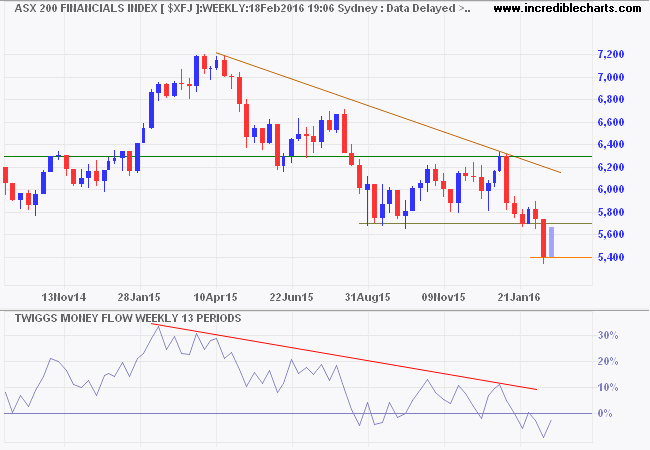
* Target calculation: 5400 - ( 5700 - 5400 ) = 5100
I'm always thinking about losing money as opposed to making money. Don't focus on making money, focus on protecting what you have.
~ Paul Tudor Jones
Disclaimer
Porter Private Clients Pty Ltd, trading as Research & Investment ("R&I"), is a Corporate Authorized Representative (AR Number 384 397) of Andika Pty Ltd which holds an Australian Financial Services Licence (AFSL 297069).
The information on this web site and in the newsletters is general in nature and does not consider your personal circumstances. Please contact your professional financial adviser for advice tailored to your needs.
R&I has made every effort to ensure the reliability of the views and recommendations expressed in the reports published on its websites and newsletters. Our research is based upon information known to us or which was obtained from sources which we believe to be reliable and accurate.
No guarantee as to the capital value of investments, nor future returns are made by R&I. Neither R&I nor its employees make any representation, warranty or guarantee that the information provided is complete, accurate, current or reliable.
You are under no obligation to use these services and should always compare financial services/products to find one which best meets your personal objectives, financial situation or needs.
To the extent permitted by law, R&I and its employees, agents and authorised representatives exclude all liability for any loss or damage (including indirect, special or consequential loss or damage) arising from the use of, or reliance on, any information. If the law prohibits the exclusion of such liability, such liability shall be limited, to the extent permitted by law, to the resupply of the said information or the cost of the said resupply.
Important Warning About Simulated Results
Research & Investment (R&I) specialise in developing, testing and researching investment strategies and systems. Within the R&I web site and newsletters, you will find information about investment strategies and their performance. It is important that you understand that results from R&I research are simulated and not actual results.
No representation is made that any investor will or is likely to achieve profits or losses similar to those shown.
Simulated performance results are generally prepared with the benefit of hindsight and do not involve financial risk. No modeling can completely account for the impact of financial risk in actual investment. Account size, brokerage and slippage may also diverge from simulated results. Numerous other factors related to the markets in general or to the implementation of any specific investment system cannot be fully accounted for in the preparation of simulated performance results and may adversely affect actual investment results.
To the extent permitted by law, R&I and its employees, agents and authorised representatives exclude all liability for any loss or damage (including indirect, special or consequential loss or damage) arising from the use of, or reliance on, any information offered by R&I whether or not caused by any negligent act or omission.

Author: Colin Twiggs is a former investment banker with almost 40 years of experience in financial markets. He co-founded Incredible Charts and writes the popular Trading Diary and Patient Investor newsletters.
Using a top-down approach, Colin identifies key macro trends in the global economy before evaluating selected opportunities using a combination of fundamental and technical analysis.
Focusing on interest rates and financial market liquidity as primary drivers of the economic cycle, he warned of the 2008/2009 and 2020 bear markets well ahead of actual events.
He founded PVT Capital (AFSL No. 546090) in May 2023, which offers investment strategy and advice to wholesale clients.
